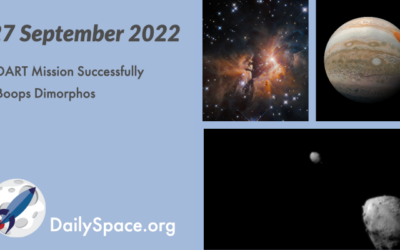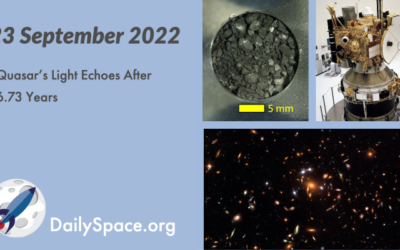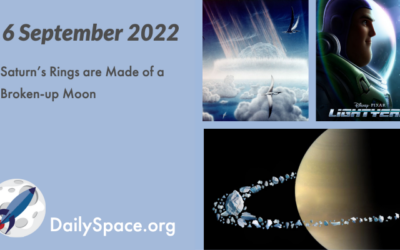
JAXA Triggers Flight Termination of Launch
Space is hard, and some days, getting rockets to work doesn’t go as well as expected. An Epsilon rocket launched by JAXA and carrying eight payloads including RAISE 3 was lost when mission control triggered the flight termination system due to an attitude issue. Plus, stars blowing dust rings, stars exploding, asteroids getting hit with spacecraft, and Europa’s geysers may not come from the subsurface ocean.
Catch us on NowMedia TV
Saturday 11pm Central / midnight Eastern
Sunday 10pm Central / 11pm Eastern
Watch live on these stations: Houston 21.10, Atlanta 22.10
or tune-in on Apple TV, Roku, YouTube Live, or Amazon Prime
DART Mission Successfully Boops Dimorphos
After ten months of space travel, NASA’s DART spacecraft arrived at the asteroid Didymos, targeted the moonlet Dimorphos, and successfully flung itself at the surface. Multiple observations confirm that the system brightened and even managed to resolve a cloud of debris. Plus, rocket launches, an update on the SLS, some broken physics, and International Observe the Moon Night.
Being a Star: Nature vs Nurture
Asteroseismologists are combining data from TESS, Kepler, and eventually, JWST to study stellar oscillations in ‘infant’ stars, with the goal of creating new models for how such young stars form and evolve over time. Plus, JWST images Mars, Hubble images stars, and SpaceX manages to launch another Starlink mission in spite of weather delays.
Quasar’s Light Echoes After 6.73 Years
Astronomers using the 1.2-meter Whipple Observatory to follow the brightness of a lensed galaxy for 14.5 years have calculated that the time delay between light arriving along the shortest and farthest paths is 6.73 years. Plus, DART, Hayabusa2, Juno, fast radio bursts, and This Week in Space History, we look back at NASA’s 1990s attempts to reach Mars.
Saturn’s Rings are Made of a Broken-up Moon
Using computer simulations, researchers have pieced together a possible scenario where Titan caused another of Saturn’s moons to break up and become the beautiful ring system we see today. Plus, organic molecules on Mars, the death of the dinosaurs, and a review of Lightyear on Disney+.
NASA Tries Fuel Tanking the SLS Again
In advance of the next scheduled launch attempt, NASA conducted another test to fill the fuel tanks onboard the Space Launch System rocket. The results were mixed, but the launch is still on schedule. Plus, a crewed launch, beautiful images, and an interview with Mike Simmons from Astronomy for Equity about sending telescopes to underprivileged students.
Mount Sharp, Mars, Shaped by Water and Wind
Data and images from NASA’s Curiosity rover found evidence that wind played a key role in erosional processes on the red planet, despite the lower atmospheric volume. Plus, astrophysics and cosmology news, a baby exoplanet, and this week in space history, we look back at an uncrewed lunar mission from Japan.


 We record most shows live, on Twitch. Follow us today to get alerts when we go live.
We record most shows live, on Twitch. Follow us today to get alerts when we go live.






